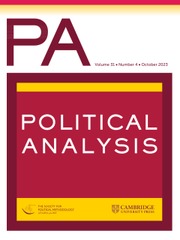Article contents
Progress in the Study of Nonstationary Political Time Series: A Comment
Published online by Cambridge University Press: 04 January 2017
Extract
Cointegration was introduced to our discipline by Renée Smith and Charles Ostrom Jr. and by Robert Durr more than two decades ago at political methodology meetings in Washington University�St. Louis and Florida State University. Their articles, along with comments by Neal Beck and John T. Williams, were published in a symposium like this one in the fourth volume of Political Analysis. Keele, Lin, and Webb (2016; hereafter KLW) and Grant and Lebo (2016; hereafter GL) show how, in the years that followed, cointegration was further evaluated by political scientists, and the related idea of error correction subsequently was applied.
Have the last twenty-plus years witnessed significant progress in modeling nonstationary political time series? In some respects, the answer is yes. The present symposium represents progress in understanding equation balance, analyzing bounded variables, and decomposing short- and longterm causal effects. In these respects KLW's and GL's articles deserve wide dissemination. But KLW and GL leave important methodological issues unresolved. They do not address some critical methodological challenges. From a historical perspective, the present symposium shows that we have made relatively little progress in modeling nonstationary political time series.
- Type
- Time Series Symposium
- Information
- Copyright
- Copyright © The Author 2016. Published by Oxford University Press on behalf of the Society for Political Methodology
Footnotes
Author's note: The author thanks Patrick Brandt for discussions about the original and current symposia and also about the strengths and weaknesses of the Bayesian approach to this subject. He also thanks Janet Box-Steffensmeier and Jim Granato for their comments. The author alone is responsible for the paper's content.
References
- 9
- Cited by


